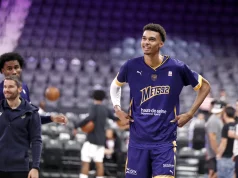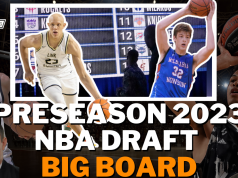Despite the lull of the All-Star break, February brought plenty of drama, excitement, and disappointment for San Antonio Spurs fans.
The Spurs lost a hard-fought battle against the Clippers but rolled over in a blowout loss against the Sacramento Kings. Dejounte Murray scored a career-high 25 points against the Thunder; two games later he went scoreless against the same team. The Spurs overcame a 19-point deficit against the Hornets and blew a 23-point lead against the Denver Nuggets.
Amidst February’s ups and downs, several trends emerged. Here we dissect some of them and try to determine if they are significant indicators of the team’s development or merely interesting footnotes along the way.
Dejounte Murray’s Growing Role
By signing Dejounte Murray to a four-year extension the Spurs signaled their belief in his ability to lead their offense as the team’s point guard.
His defensive prowess was already well-known, but recently Murray has been also delivering the offensive production to justify his significant place in the Spurs’ future plans. February saw Murray’s offensive contribution grow in both quantity and quality.
Murray played over 30 minutes three times in February, after only doing so in three games from October through January. He matched this vote of confidence from the coaching staff with growing confidence of his own.
Murray shot 47% on threes in February, although on only 1.5 attempts per game. Defenses tended to sag off of him, worried about his ability to get to the basket. Against this, Dejounte has developed a reliable pull-up jumper that is very difficult to contest given his height and high release. Here, he sets it up with his handle, putting Nikola Vucevic on his heels and pulling up into an easy jumper.
Playmaking
Just as important as his scoring is Murray’s growth as a playmaker. Going into February, he had one game all year with seven or more assists. In the 11 games in February, Murray hit that mark four times.
Murray is delivering more dimes while cutting back on the poor decisions that frequently led to turnovers earlier this season. The growth has been gradual all year, but the past month saw his playmaking skills come together in a rapid and impressive fashion.
| Month | Assist/Turnover Ratio | Turnover Rate |
| October | 1.82 | 14.9% |
| November | 1.29 | 14.4% |
| December | 1.92 | 13.5% |
| January | 1.92 | 12.8% |
| February | 3.85 | 7.1% |
Often, as young point guards attempt more incisive passes, their turnover rate will rise along with their assists. To make dramatic improvements on both sides of the assist-turnover ratio indicates the level of coaching and self-improvement that is driving Murray’s success.
One last highlight on the past month’s statistical resume: His 3.85 assist/turnover ratio is 20th in the league of 294 players who averaged over 15 minutes a game. All of the 19 players above him have lower usage rates – meaning Murray has maintained exceptional efficiency handling and distributing the ball despite a more challenging offensive workload than many of the players with comparable numbers.
Many have questioned Murray’s offensive ceiling. While those questions have not been definitively put to rest, his performance in February was a promising step and a promising sign for the Spurs’ future.
How Bad is Rudy Gay’s Decline?
On the opposite side of the career arc from Dejounte Murray is, unfortunately, veteran forward Rudy Gay. Last year and parts of this season saw Gay settle comfortably into a backup role. No longer an athletic powerhouse due to aging and injury, Gay’s skill and size still allowed him to play as a reliable bench scorer.
Cold Shooting
Last season, Gay’s effectiveness with the bench unit was propped up by his uncharacteristically hot three-point shooting: 40.2% vs. his career 34.5% mark. This season it is down to 32.1%, but just as harmful as his declining accuracy is the reduction of confidence in aggression in Rudy’s game that accompanies it.
Up until his three-point outburst in the last game of February, Gay was below 30% for the month. He became unwilling to launch even open threes:
This hesitancy leads to further offensive woes for the Spurs. Not only does he pass up an open three for a less efficient midrange shot, but he also allows the defense to clog up the paint. In that clip against the Mavericks, Kristaps Porzingis, an elite rim protector, is Gay’s defender. Not shooting the three means Porzingis doesn’t need to close out – leaving him free to contest the drives of players like DeRozan, White, and Murray.
Fewer Free Throws
Another sign of his reduced aggressiveness is the drop off in Gay’s free throw rate. For much of his career, Gay could drive by larger defenders and overpower smaller ones, getting to good spots near the basket and drawing fouls. In February, however, his free throw rate of 14.8% is down from both his season and career numbers:
| Effective FG% | True Shooting % (incorporates free throws) | Free Throw Rate | |
| Career | 49.1% | 53.6% | 27.3% |
| Season | 48.8% | 53.6% | 23.8% |
| February | 46.6% | 50.1% | 14.8% |
Rudy’s shooting will likely tick back up. He has had a positive net rating all year until February. His horrendous -16.4 points/100 possessions in the month indicate shortcomings but is also a figure unfairly magnified by a small sample. However, as his effectiveness declines with age, Gay will need to adjust his game and perhaps take a smaller role in support of the Spurs’ other players.
Lineup Tinkering
Two quick looks at interesting lineups that we saw in February:
Lyles/Gay at Center
In the end of February and in the first few games of March, Popovich deployed rarely-seen lineups with Trey Lyles or Rudy Gay at center. This was partially out of necessity due to Aldridge’s and now Poeltl’s injuries, but against Dallas Lyles got the start at center and Poeltl (healthy at the time) spent most of the game on the bench.
The mobility of Lyles and Gay at center opens up new options for the Spurs. They can play schemes where they switch everything on defense, and Lyles proved much more effective than Poeltl at covering the sharpshooting Kristaps Porizingis beyond the arc.
Lyles and Gay can run pick and roll together; while this is not a pathway to consistent offensive success, its novelty can catch defenses off guard, and both Lyles and Gay can score at the basket or with jumpers like this:
Against the right matchups, the small-ball look offers intriguing offensive and defensive versatility. Monday’s Pacers game showed how Lyles and Gay could be overpowered by traditional bigs, but having one of them at center could be a useful tool at times for Gregg Popovich.
The Murray/White Backcourt
The lineup Spurs fans have been clamoring for all season. Dejounte and Derrick have played only 94 minutes together all season, but almost half of them (45 minutes) came in February. In this limited sample size, the pairing significantly increases the team’s pace and tightens their defense. It sparked their rousing comeback against the Hornets on February 1. Their 103.2 defensive rating would be second only to the Milwaukee Bucks.
| Off. Rating | Def. Rating | Pace | |
| Season Avg. | 111.2 | 112.6 | 100.54 |
| White and Murray on the floor |
106.9 | 103.2 | 106.24 |
Murray and White each need to make more threes to open up driving lanes for the other if the team’s offense will perform better when they share the court. This should be achievable, as their shortcoming this year has not been three-point accuracy, but the reluctance to launch them.
More than the 8th seed, Spurs fans are watching for indicators that their team is on track to improve in the coming seasons. There has been no shortage of disappointments in the past month and throughout the season, but Spurs fans will be hoping that the team’s positive flashes are sustainable for the season’s home stretch and beyond.
Follow me @fern_garcia for more Spurs talk.






